NJC: Looking back… looking forward
Looking back
An interdisciplinary chemistry journal
It has been one year since NJC re-oriented its editorial line to place an emphasis on interdisciplinary research, to provide chemists working at the interfaces with other disciplines a place to publish their findings. The articles we publish offer new directions in chemistry and in other fields.A selection of the articles published in 2011, reflecting this focus, demonstrate the contributions of chemistry to archeology, textile science, medicine, toxicology, materials for energy, the environment and electronics, the origins of life, safeguarding the environment, analytical applications, and chemical engineering. At the time this editorial was written, ACS Noteworthy Chemistry had highlighted three NJC papers this year, a rather good percentage of our published content (Z. Y. Liu et al., New J. Chem., 2011, 35, 137–140; R. Haddoub et al., New J. Chem., 2011, 35, 1351–1354; O. Plietzsch et al., New J. Chem., 2011, 35, 1577–1581).
Focus reviews
The first Focus mini-review, which give a focused look at topics of high current interest, was published one year ago. The 7 Focuses published in 2011 proved to be popular, generally amongst NJC's Top 10 most downloaded articles each month. They will continue to appear on a regular basis in NJC, along with the longer Perspective reviews.Themed issues
Two themed issues were published in 2011 (Fig. 1). The June issue featured a collection of 24 articles and reviews dedicated to the synthesis, properties, modeling and processing of smart molecular materials (http://pubs.rsc.org/en/journals/journalissues/nj#!issueid=nj035006&type=current). The October issue comprised of 56 contributions was officially presented to Didier Astruc during the International Symposium on Coordination Chemistry and Molecular Materials held in Bordeaux (http://pubs.rsc.org/en/journals/journalissues/nj#!issueid=nj035010&type=current).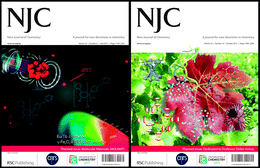 | ||
| Fig. 1 Covers of the June and October 2011 themed issues. | ||
NJC symposium
The 1st NJC Symposium, held in Strasbourg last April, was one of the highlights of 2011 (http://blogs.rsc.org/nj/2011/02/17/2011-njc-symposium-new-directions-in-chemistry/). Eight of the board members (Fig. 2) presented their research, showcasing the diversity of the coverage of NJC: enzymes in synthesis, corrosion inhibitors, binding of harmful f-elements, nucleic acids as biological inhibitors, molecular machines, crystal forms, reaction mechanisms, organic solids.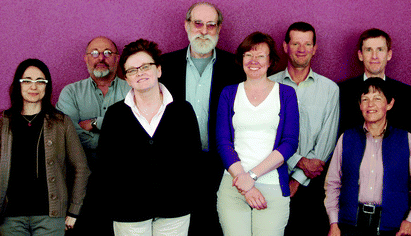 | ||
| Fig. 2 NJC board members in Strasbourg. Front row: Fabrizia Grepioni, Barbara Nawrot, Helen Hailes, Odile Eisenstein. Back row: Wais Hosseini (co-Editor-in-Chief), Jerry Atwood (co-Editor-in-Chief), Peter Junk (Associate Editor), Michael Scott (Associate Editor). | ||
Conferences
NJC editors and board members attended many conferences in 2011, to meet chemists, promote NJC to them, and support the community of chemists. We were present in one way or another at 25 conferences in 2011, with financial support to many of them (Fig. 3), for a total of almost 9000 €. This included the sponsorship of the 4 young plenary speakers at the XIX EuCheMS Conference on Organometallic Chemistry and NJC Poster Prizes (see http://www.njc.cnrs.fr/spip.php?article20&lang=en) to 8 young chemists.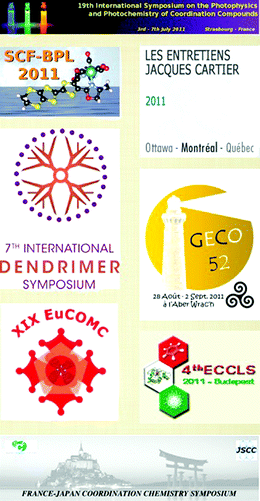 | ||
| Fig. 3 Logos of some of the conferences that NJC sponsored in 2011. | ||
New faces
Dr Eva Balentova joined the Montpellier editorial office (Fig. 4) as Deputy Editor last summer. Eva has a background in organic and natural product synthesis, gained during her research career in Slovakia, Finland, Spain and France. Cynthia Challencin now works part-time as our publishing assistant, while she studies for her Masters in translation. Dr Ling Peng, a CNRS researcher in the interdisciplinary Center on Nanoscience in Marseille, is the third assistant editor (Fig. 5) on the NJC team. Her research interests are centred on dendrimers for biological and medical applications.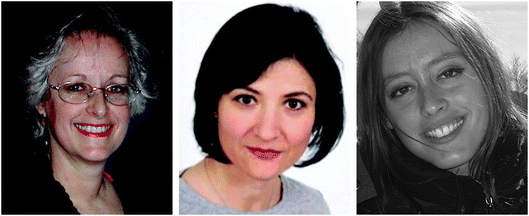 | ||
| Fig. 4 Montpellier office staff: Denise Parent (Editor), Eva Balentova (Deputy Editor), Cynthia Challencin (Publishing Assistant). | ||
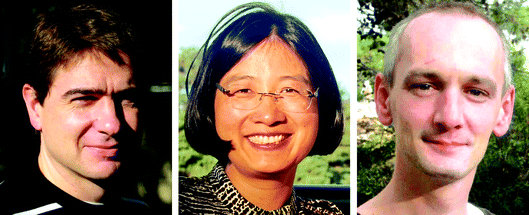 | ||
| Fig. 5 Assistant editors Yannick Guari, Ling Peng and Laurent Vial, attached to the Montpellier office. | ||
These three ladies join assistant editors Drs Yannick Guari (materials chemistry) and Laurent Vial (organic and supramolecular chemistry), and NJC editor Dr Denise Parent (physical chemistry) in the Montpellier office.
Another “newcomer” is Dr Jamie Humphrey, the new RSC Editor of NJC (though he served in this capacity once before). He is seconded by Dr Ruth Doherty and Mr Matthew Cude in the Cambridge office.
You can read biographies of the entire NJC team on our CNRS website (http://www.njc.cnrs.fr/spip.php?article16&lang=en).
Editorial board
Two members (Fig. 6) were welcomed onto the Editorial Board in 2011: organic photochemist Jarugu Narasimha Moorthy from India and American vanadium chemist Debbie Crans.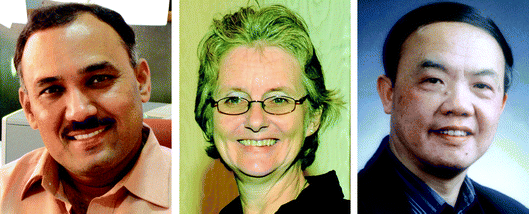 | ||
| Fig. 6 NJC Board members Jaruga Narasimha Moorthy, Debbie Crans and Jiannian Yao (appointed in 2010). | ||
Polish biochemist Barbara Nawrot has completed two terms on the board and thus has stepped down at the end of 2011. We warmly thank her for her enthusiastic support of NJC, notably as guest editor of a 2010 themed issue on biophosphates.
Looking forward
NJC symposium
Following the success of the first edition, we are hard at work on the organisation of the 2nd NJC Symposium. But shhhh… it's still a secret until all of the details are finalised. Keep an eye on the NJC blog (http://blogs.rsc.org/nj/) to find out more in the coming months.Conferences
In the meantime, NJC is a sponsor of the 7th International Symposium on Macrocyclic and Supramolecular Chemistry, which will be held in January in Dunedin, New Zealand.Themed issue
In February we will publish the Dendrimers II themed issue, guest edited by former Editor-in-Chief Jean-Pierre Majoral. The issue will contain about 30 reviews and articles by world experts on dendrimers, with a focus on biomedical applications. Look for it soon!
Looking forward by looking further—beyond the traditional boundaries—NJC presents chemistry as the central science.
Wais Hosseini and Jerry Atwood
Editors-in-Chief
Denise Parent (CNRS) and Jamie Humphrey (RSC Publishing)
Editors
RSC Publishing growth and successes
Journals from RSC Publishing are delivering impressive results on Impact Factors, growth in quality content and international visibility and influence. The 2010 Journal Citation Reports® proved that our quality is better than ever, and that is thanks to our authors and referees. Of the top 20 journals in the multidisciplinary chemistry category, 25% are from RSC Publishing. Plus 83% of our journals listed in this year's report have an IF above 3.The number of articles published in our journals has almost doubled in just two years—and our share of the total has also nearly doubled in that time.
So more and more authors—from 70+ countries in 2011—are trusting us to ensure their research is communicated to the global community. Our Editorial and Advisory Boards are international, and our publishing operation is supported by offices in USA, China, India and Japan. Plus our content is downloaded by growing numbers of readers in virtually every country in the world.
These facts demonstrate that RSC journals are increasingly valued as a key resource for the very best research: www.rsc.org/journals
Books, delivering the latest research advances, information, opinions and perspectives in modern science, confirm our reputation as one of the fastest and most dynamic publishers in the world.
In an age where content is key, we understand the importance of your online chemical science resource. The RSC eBook Collection now holds more than 1000 books, equating to over 25![[thin space (1/6-em)]](https://www.rsc.org/images/entities/char_2009.gif) 000 chapters, and spanning more than 40 years. The publication of our 1000th eBook in 2011 was a celebratory milestone.
000 chapters, and spanning more than 40 years. The publication of our 1000th eBook in 2011 was a celebratory milestone.
We continue to provide expert, interdisciplinary chemical science books: over 100 new print titles are planned for 2012 alongside the launch of several new series including:
• Food and Nutritional Components in Focus
• New Developments in Mass Spectrometry
• New Developments in NMR
• RSC Smart Materials
Our ability to deliver fast, accurate information to our customers was rewarded by the BIC Basic Award, an accolade held by few publishers: www.rsc.org/books
RSC Publishing Platform
Access one million journal articles and book chapters in one simple integrated search.The RSC Publishing Platform provides the most valued interface and features that connect you with the highest quality scientific research. With one single search box, students, academics, researchers, scientists and professionals can easily access our books, journals and databases: www.rsc.org/platform
To access content on the go, download our RSC Mobile app for your electronic device: www.rsc.org/rscmobile
Free online access
Free online access is available to all our newest journals, and much more—all you need to do is register for an RSC Publishing Personal Account. Once logged in, you will be able to access all our free content including:• All content of our newest journals for the first two volumes
• Any articles that are part of a special free access promotion (e.g. ‘hot’ papers, web theme issues, etc.)
• A sample chapter from each book in the RSC eBook Collection
With your username and password you can access free content any time, any place—all you need is internet access. You can also save searches and favourite articles. Register now at www.rsc.org/personalregistration
If your institution/organisation is a current customer or on a free trial with IP registered addresses, you will be able to access all free content automatically, if authenticated. To request free access for your institution/organisation, go to www.rsc.org/freeaccess.
ChemSpider: the free chemical database
www.chemspider.com gives you the most comprehensive view of freely available chemical data from a single online search.Search: over 26 million structures from 400+ sources
Discover: related information from RSC publications, Wikipedia, Google Scholar and PubMed
Share: add and curate data
Access ChemSpider anytime, anyplace, anywhere with the free ChemSpider mobile app, www.rsc.org/ChemSpidermobile
ChemSpider SyntheticPages is a freely available interactive database of synthetic chemistry. It contains practical and reliable organic, organometallic and inorganic chemical syntheses, reactions and procedures deposited by synthetic chemists. Synthetic methods on the site are updated continuously by chemists working in academic and industrial research laboratories. ChemSpider SyntheticPages encourages submissions from graduate students, postdocs, industrialists and academics. Discover ChemSpider SyntheticPages today: http://cssp.chemspider.com
RSC conferences and events 2012
The RSC organises a broad range of conferences and events to promote the advancement of the chemical sciences. Please visit the website for the most up to date listing: www.rsc.org/eventsThe major scientific meetings planned for 2012 include:
Challenges in organic chemistry and chemical biology (ISACS7), 12–15 June 2012, Edinburgh, UK, www.rsc.org/isacs7
Challenges in inorganic and materials chemistry (ISACS8), 19–22 July 2012, Toronto, Canada, www.rsc.org/isacs8
Challenges in nanoscience (ISACS9), 31 August–3 September 2012, Xiamen, China, www.rsc.org/isacs9
| This journal is © The Royal Society of Chemistry and the Centre National de la Recherche Scientifique 2012 |

